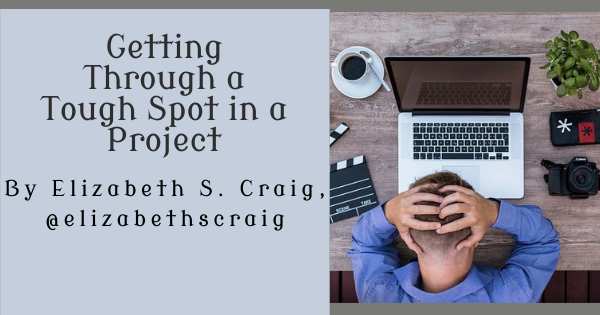by Elizabeth S. Craig, @elizabethscraig
From time to time, everyone hits a speed bump in their manuscript. You might have been sailing through, easy as anything. Then, suddenly, you’ve come to a screeching halt. For whatever reason, it’s messed up your forward motion on the book.
Here are five ideas for working your way through it:
Skip the scene that’s creating the problem. Sometimes you might not be in the right mood to tackle a particular scene. Or maybe you’re not exactly sure how you want to handle writing it. Instead of waiting, you could just skip that scene and move on to the next one, keeping your forward momentum on a project.
Work backward from a spot you feel good about. Let’s say you’re really stuck . . . perhaps in the middle of your book (a common sticking point for writers). Maybe you know the ending, but you’re not sure how to connect where you are now with where you want to be at the end of the book. Consider working backward from the ending to the point where you got stuck.
Write on paper. I’m not sure what it is, but something about writing longhand really has the ability to help me make sense of troublesome scenes. You could try writing a few paragraphs on paper and see if it makes a difference.
Brainstorm ways of getting through it. I like doing this on paper, too. I basically just make a list of all the different ways the scene could possibly go. Then I choose one of them . . . and then usually will use bullet points (sort of a beat sheet) for the scene to ensure I can zip through it when I’m back on my laptop.
Set a timer when you work on the tough scene. Like any tough task, it can make things easier to know you’ll only be working on it for a limited time. It definitely helps me get started when I know there will be a defined endpoint. A timer set for ten minutes (or even five, if you’re really stick) can help.
What do you do when you get stuck when working on a book?
5 Tips for Getting Through a Tough Spot in a Project: Share on XImage by Lukas Bieri from Pixabay

I think sometimes writing on paper really helps. It’s more free-form, which frees the mind.
It’s my first go-to, for sure.
I love your ideas, Elizabeth. If you don’t find ways around them, those tough places can keep your manuscript mired. I especially like the one about skipping the scene and moving on. Usually (for me, anyway), that sets the context for me, so I can go back later and fix the plot hole or bad dialogue or whatever is making the scene hold the story back.
The nice thing is that there are no rules! It’s whatever works best for us. :)
I’ve always skipped the scene. Then when I come back to it, I usually see how to connect the dots.
It’s amazing how just skipping over the problem and coming back to it makes us see things more clearly.
Getting stuck. Ugh. My daughter says I’m the best brainstormer she knows, but one thing has to happen. I have to turn off distractions. Also, writing things down on real paper, I think, slows our thought process and clears the mind. Love this list especially the one where you backtrack. Retracing our steps shows so much.
Teresa
Distractions are the worst! And such a part of today’s world. Paper is a great solution, for sure!
Write on paper- then you can draw pictures or doodle timelines.
Great idea, Cris!